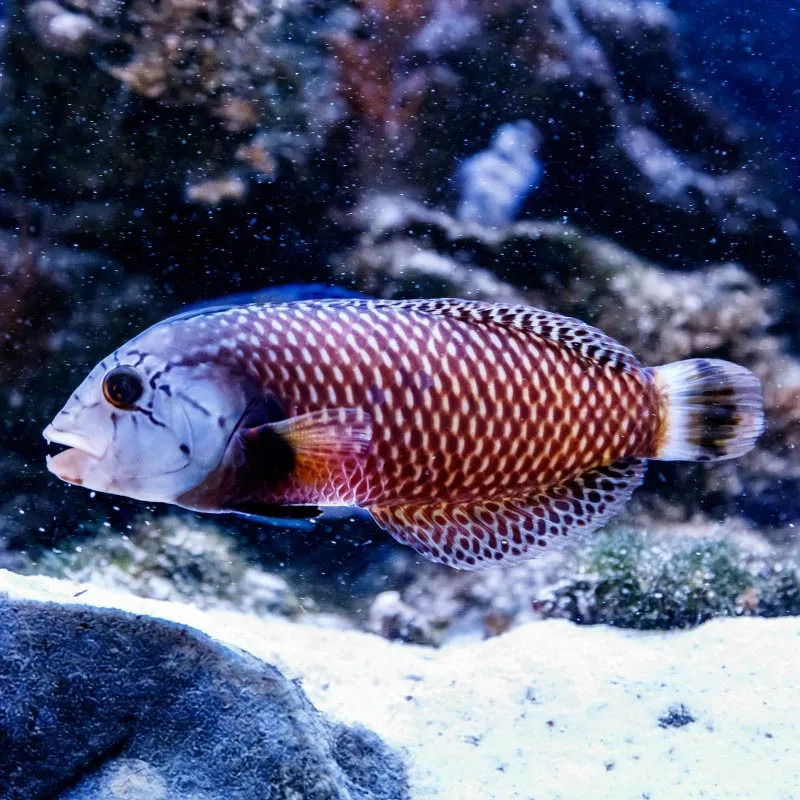Stocks Available
Red Line Wrasse
SKU:226474
Halichoeres biocellatus
2.75-4 INCH

Stock Available
Introduction: • Species: Dragon Wrasse • Common Names: Rockmover Wrasse, Dragon Wrasse • Natural Habitat: Found in shallow reef environments, rocky substrates, and coral rubble areas across the Indo-Pacific region. Physical Characteristics: • Appearance: Juveniles have a striking dragon-like appearance with elongated, leaf-like dorsal fins and a brownish-red body. As they mature, their colors shift to a more muted brown or greenish body, and their elongated fins become less pronounced. • Size: Can grow up to 12 inches (30 cm) in length. • Lifespan: Typically lives 5-10 years with proper care in captivity. Habitat Requirements: • Tank Size: Requires a minimum of 125 gallons due to its active nature and size. • Water Conditions: o Temperature: 72-78°F (22-25°C). o pH: 8.1-8.4. o Salinity: 1.020-1.025 specific gravity. • Aquascaping: Provide a substrate of sand and rocks as the Dragon Wrasse enjoys digging and moving rocks in search of food. Ensure the rocks are securely placed to prevent damage to the tank structure. Diet: • Primary Diet: Carnivorous; feeds on crustaceans, mollusks, and small invertebrates in the wild. • Supplemental Feeding: Offer meaty foods like chopped shrimp, squid, and frozen or live foods such as brine shrimp and mysis shrimp. • Feeding Frequency: Feed multiple times per day due to their high energy levels. Compatibility: • Temperament: Juveniles are generally peaceful but become more aggressive and territorial as they mature. They can rearrange rocks and substrate in the tank. • Suitable Tank Mates: Compatible with larger, semi-aggressive species, such as triggerfish, tangs, and other wrasses. • Incompatibilities: Not suitable for small, delicate fish or invertebrates, as the Dragon Wrasse may prey on them or cause disruption by moving rocks. Care Level: • Difficulty: Moderate; requires stable water conditions, ample space, and a varied diet. • Health Monitoring: Monitor for signs of stress or disease, particularly in relation to water quality fluctuations. A secure tank lid is important, as wrasses are known jumpers. Breeding: • Breeding in Captivity: Rarely bred in home aquariums due to their complex reproductive behavior and specific requirements. • Spawning: In the wild, Dragon Wrasses are egg-layers, with eggs usually released into open water. Economic Considerations: • Market Demand: Moderate demand among marine hobbyists, particularly for their unique appearance and active behavior. • Pricing: Typically mid-range in price, depending on size and availability. Sustainability and Conservation: • Wild Population: Generally stable, though localized overcollection may be a concern in some regions. • Aquaculture Efforts: Limited captive breeding; most individuals in the aquarium trade are wild-caught. • Conservation: Support sustainable collection practices to reduce the impact on wild populations. Conclusion: The Dragon Wrasse is a fascinating and dynamic addition to large marine tanks, known for its rock-moving behavior and striking juvenile appearance. While its care requires attention to its habitat needs and diet, it can be a rewarding species for experienced aquarists who can accommodate its active and sometimes aggressive nature.
Data sheet
16 other products in the same category:
Customers who bought this product also bought: